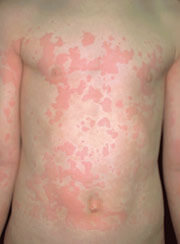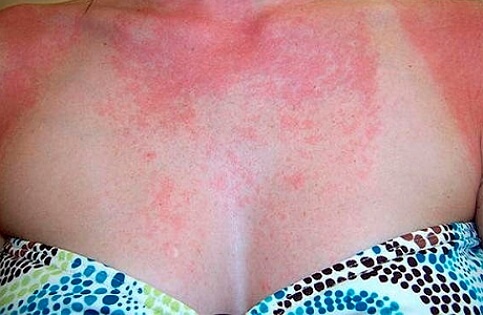Chronic urticaria
 Chronic urticaria is a rash, which is characterized by the manifestation of an allergic reaction in the form of blisters for more than six months. The cause of the disease can be established only in every fourth case. People are affected by all ages and ethnic groups, young people are more often ill. The diagnosis of complications does not cause, it is much more difficult to determine in the treatment, as well as in prevention. The very course of the disease is very unpredictable, dragged on for months and years.
Chronic urticaria is a rash, which is characterized by the manifestation of an allergic reaction in the form of blisters for more than six months. The cause of the disease can be established only in every fourth case. People are affected by all ages and ethnic groups, young people are more often ill. The diagnosis of complications does not cause, it is much more difficult to determine in the treatment, as well as in prevention. The very course of the disease is very unpredictable, dragged on for months and years.
The sick should be checked for influence of such factors as intestants, inhalants, injectants, infectious diseases, internal diseases.
Injestants are substances that enter the digestive system and act as strong provokers of urticaria. Such food substances include medicines( antibiotics) and food additives.
Inhalants - these include dust, pollen, and feather.
Injectants - these include injections of drugs, bites of wasps, bees, and other insects.
Infections both viral and bacterial, parasitic and fungal.
internal diseases which include chronic infections, and diseases such as thyroid cancer and lupus
Chronic urticaria - Causes
cause of chronic urticaria are the mast cells of the skin that fail on the liver, gastrointestinal tract, kidneys, Outbreaks of chronic infection, toxicosis of pregnant women, as well as decay products of malignant tumors. From the above, it can be seen that chronic allergic reactions can act as a clinical manifestation of certain systemic diseases.
The reason can often come from chemicals that are capable of inducing the disease by contact. These substances are the hygiene products: toothpaste, shampoos, detergents, chemical allergens, cosmetics
Chronic urticaria -
symptoms of disease is characterized by migratory swollen blisters, stains in the form of figures, rings of red and pink. The sizes of the centers of lesions reach forms with a palm. The foci are able to merge and acquire polycyclic contours, and in due course to change the form, the sizes. In themselves, rashes can pass for 24 hours and then appear as new foci. Some patients with extensive lesions suffer systemic symptoms: often concerned about shortness of breath, nausea, painful itching noisy breathing difficulties, headache and abdominal pain, diarrhea
diagnosis of chronic urticaria
Laboratory tests can provide a good help in the diagnosis of chronic urticaria and include X-rays, To exclude sinusitis, as well as radiography of teeth, to exclude a hidden abscess, a blood test, a stimulation test for thyroid stimulating hormone, an express test for determiningStreptococci and smear from the throat, a test for microsomal antibodies.
But the differential diagnosis is carried out with the following diseases: Physical urticaria, urticarial vasculitis, erythema multiforme, pemphigoid bulezny. Physical
urticaria represents momentary hives caused by physical causes: scratches, pressure, heat, vibration, cold, and ultraviolet irradiation.
urticaria vasculitis - is a systemic disease in which can be developed lupus, very reminiscent of chronic urticaria, but differs from it blots purpura. Urticaria vasculitis can be confirmed by histological examination of biopsy material.
A bulky pemphigoid has early urticarial foci, which are characterized by the formation of blisters.
Exudative erythema is characterized by an infectious-allergic origin, which affects the skin and mucous membranes
Treatment of chronic urticaria
Chronic urticaria is characterized by a daily( about 6 weeks or more) appearance of blisters, the existence of which lasts up to 24 hours. Chronic rashes develop in different parts of the skin and are replaced by remissions of different durations. Treatment of the chronicle begins with the elimination of the cause of the disease and the appointment of a hypoallergenic diet that eliminates the products that cause histamine-liberation. These include coffee, nuts, citrus fruits, chocolate, honey, cheese, bananas, sauerkraut, smoked products, fatty and fried foods. It is necessary to abstain from drugs and alcohol. Among the contraindications was a sauna and a swimming pool, bathing in hot water, increased rubbing of the skin with a washcloth, and a towel. It is necessary to give preference in the sock to cotton fabrics and forget to use antistatics, to do laundry with hypoallergenic detergents.
Chronic urticaria is treated with antihistamines.
Hydroxysin is prescribed from 10 to 25 mg, with acute necessity every four hours, 100 mg. Hydroxysin has a sedative effect.
Clarenex( Desloratadine), Zirtek( Cetirizine), Telfast, Allegra do not cause hypnotic effect and therefore are recommended during the day.
It is important to note that the main sign of urticaria, which is easy to determine the severity of the disease, is pruritus and the effectiveness of treatment is determined by reducing itching of the skin. It should be emphasized that a slight reduction in blisters and itching does not cause an antihistamine drug to be canceled. The time factor in treatment is very important and the absence of a result within two days does not give grounds for canceling an antihistamine drug. Evaluation of the efficacy of the prescribed antihistamine drug is carried out after a lapse of 7 days. And for effective treatment of chronic urticaria, up to 6 weeks of taking antiallergic drugs is necessary.
For those who are ill, remember that the key to successful treatment of chronic urticaria is correction and treatment of concomitant diseases.



